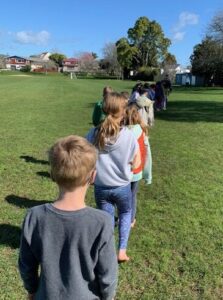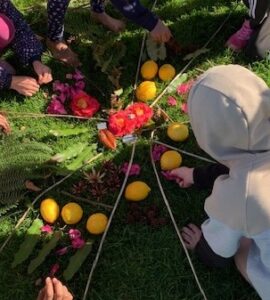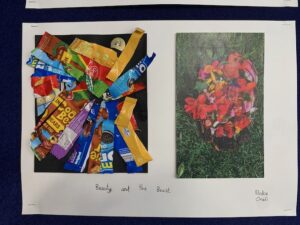But is it art? It’s an age-old question, and this was a question the Year 3 students in Room 15 at Hillcrest Normal School considered when they took on their arts inquiry using the Mantle of the Expert (MOTE). This dramatic inquiry-based approach to teaching and learning enables the children to become experts through authentic tasks within a fictional organisation, being commissioned to undertake a job.

Walking in line during the meditation activity.
In this case the Middle Syndicate classes were artists at “Te Ika a Māui School of Arts”. Each class became a studio within this imaginary arts school, learning about art and taking on the responsibility to produce a final piece for an art gallery. The commission was set around how the ‘artists’ interpreted the whakatauki ‘āta mātai, mātai whetū’ – Firmly grounded in this land, looking towards the stars. Reading, writing and maths is woven through all MOTE as well as embracing the arts.
At the start of the Term, teacher Sophie Tayler sought advice on giving this inquiry an enviro lens and was looking for inspiration. Sophie invited me in, as an artist, to share my practice of creating nature-based art interventions and some ideas with the class. I shared examples of my work and how I’m interested in creating art experiences that enable a deeper connection with nature.
On a cold and clear winter’s day, we went out onto the school field, removed our shoes and socks and took part in a ‘walking meditation’ – a practice that involves a very slow, mindful walk in a circle. As we walked in silence, we focused on the calm and peaceful flow of our in-breath and out-breath, feeling the sensation of each step connecting with the earth and imagining that we were kissing the earth with each footstep. At the end, many students commented how much calmer they were feeling. With only 15 min left, we created a nature mandala together, building up layers of patterns and colours from leaves, twigs, flowers and seeds from the school grounds to create a simple ephemeral and collaborative artwork. While we didn’t have a lot of time, it was enough to sow the seed with the students – that art didn’t have to be a painting or a sculpture, it could also be an experience, a process, and temporary in nature. By being encouraged to slow down they started to see details in nature that they hadn’t noticed before.

Gathering leaves and petals from the school gardens.

Making a mandala.

The Divider
“I want to show that we can do better. I want people to tell everyone that if you see rubbish lying around then put it in the bin. I called it The Divider because I wanted to separate the two worlds. The beautiful utopia (nature mandala) and what we are in now (rubbish),” said Sid, talking about his piece ‘The Divider’.
Over the next four weeks, Room 15 experimented with the language of nature mandalas.
“It allowed us to explore colour, pattern, texture and design through an environmental and te ao Māori lens. I really wanted to create some art with the children which would provoke some thought in both the tamariki and the viewers of the artworks”. – Sophie Tayler, teacher

Care of Nature

Beauty and the Beast
As art works for the final exhibition, they would each create a diptych, juxtaposing a mandala made of rubbish collected from the school with a mandala made of beautiful natural materials, also collected from our school. It would be a “striking visual contrast” and really begs the question, “What do we want for this land, for our future?”
Sophie: explained, “To finish the art I wanted the tamariki to name their work in such a way that shows their understanding of the message and also makes the viewer really consider what they are looking at. The names speak for themselves!”

The world of ugliness and loveliness
After creating their nature mandalas some of the children reflected:
- I knew that nature was beautiful, but bringing it together made it more beautiful
- It was hard to start off, but once we got a section done it got easier and easier
- I’ve made mandalas before, but it’s always rushed. When I slowed down it started to look really cool
- I learnt when you go slowly and try harder it looks quite nice.
“It was a very mindful experience, and the children loved collecting the natural materials. They marvelled at the colours they found and also the softness of petals they handled.” – Sophie Tayler, teacher

The art exhibition displayed in the school hall.
On the day of the exhibition opening, each child took their whānau through the art gallery in the school hall, then in classrooms showed them their art portfolios and talked about their learning in MOTE.
“I wanted people to know that if we keep on littering the plants might die. I love that you can definitely see the difference between the beast of the yukky rubbish and then you can see all the beautiful nature. It really makes the point that…Do you want the world to be like this rubbish or do you want the world beautiful (and filled) with bumble bees and butterflies?” – Elodie, creator of ‘Beauty and the Beast’
The vibe in the gallery was palpable and it was obvious how proud the students were of their own art and that of their peers. The artworks have also created a ripple effect through the school. Other Hillcrest Normal teachers have told Sophie that Room 15’s exhibition has been discussed and even written about in other classrooms. Some Room 15 students have now been collecting rubbish from the playground during their break times demonstrating one of the impacts of their learning.

Careful placement of collected items to express messages.